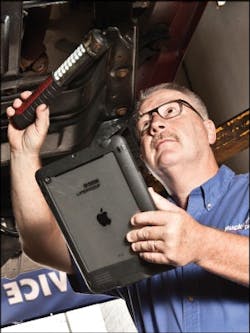The check list is fairly long, if not tedious, for something as common and everyday as informing a customer of the repair needs of his or her vehicle. But Greg Buckley went down the list item by item:
Look up the customer’s vehicle and contact information. Check.
Review the original complaint and the technician’s findings. Check.
Take video and photos as visual examples of the work needed. Check.
Send the content, and a brief explanation, to the customer. Check.
Answer any customer questions, and sell the work. Check.
Take a U-turn at the light and return to the shop. Check?
“A $3,200 job, and I did all of that on the test drive, hands free in a matter of a couple minutes,” Buckley says. “That’s what this thing can do.”
This thing is Google Glass, the wearable computing system from Google. Think of it as a smartphone in eye-glasses form—a capable and intuitive piece of technology that navigates through applications and programs based on the user’s eye movements and voice commands.
With a seemingly equal amount of critique and praise, Google Glass has sent waves through the technology world, many heralding it as the beginning of a “wearable technology” movement.
Buckley simply looks at it as the next great shop tool for customer communication, something that his Wilmington, Del., shop, Buckley’s Auto Care, has already reaped the benefits of. Buckley has taken the latest trend in consumer-focused technology and turned it into a useful, purposeful tool in his shop’s 47-year-old customer-service processes.
“It’s not about getting fancy new toys,” Buckley says. “It’s finding solutions to problems in your shop. It’s looking at new technology that’s available and figuring out which ones will work [for your shop] and which ones won’t.”
The Backstory
Everything Buckley needed to learn about customer service, he picked up more than 40 years ago, as a teenager pumping gas at his father’s service station.
“I was just in high school, but we didn’t have service writers and a bunch of techs and things,” he says. “You would pump the gas, ask if you could look over the car, make diagnoses, write up service and try to sell them that work. You had to do every single job in the shop, for each person who just wanted gas.”
And Buckley quickly learned the secret to making those customers comfortable and selling all necessary work: effective communication.
“You’re trying to inform them, demonstrate the need—walk them through it, if you have to—make a connection and show that you’re honest and trustworthy,” he says. “It’s the same concept now. It hasn’t changed. We just have to find different and better avenues to get those messages across. You need to find the best way to get your message across.”
That service station, over the years, adapted into Buckley’s Auto Care. Buckley and his brother, Steve, purchased the shop from their father in 1995, and Buckley has always focused on utilizing the latest technology to connect with customers.
Search engines like Google and Yahoo are the modern Yellow Pages, Buckley says. Your shop’s web presence is its word-of-mouth reputation.
One way to ensure you maintain that reputation is to build your web presence through content that positively affects search engine optimization and positions your shop as an expert in your area. Blogs, photos and videos are simple, easy ways to do this.
Buckley’s Auto Care has a YouTube page with nearly 600,000 views and more than 16,000 minutes of video consumed by viewers—incredible numbers for any small business, let alone a repair shop.
Buckley says to avoid marketing-type content and stick to things consumers would regularly search for online: videos on how to install child seats in a vehicle, how to check a vehicle’s oil level, how to replace wiper blades, how to fill a car with gas, etc.
“They may seem basic, but people are searching those things,” he says, “and when they find your video, they see you, they see your shop and it builds your credibility right there.”
He was one of the first shops in his region to have a functioning website in 1999. He’s used digital photos and videos to help sell work and update customers since the early to mid 2000s, first on cameras, then on smartphones. His shop utilizes text message and email communication through GoogleVoice, and Buckley has created a YouTube channel for the shop that has nearly 600,000 views.
All of these tools have played a part in the 5,500-square-foot shop’s growth to becoming a million-dollar business.
“People ask if I’m super into technology because of the things we do, and I say no, not really,” Buckley says. “It’s about communication. I’m obsessed with my message being perceived correctly, having the customer really understand us. That’s what these tools do. If you understand your need and the customer’s need, you can match the right tool to meet those.”
The Problem
Buckley takes the same approach to analyze each process in his shop—map out the procedures, step by step; measure the efficiency through corresponding key performance indicators (KPIs); and identify the bottlenecks.
He reviews his shop’s systems regularly (some weekly), and is always looking for new solutions.
Smartphones helped streamline his shop’s customer contact processes in recent years, but as recently as last December, Buckley’s team often felt bogged down by it; not the amount of time as much as the annoyance of tapping away at a small touch screen, switching between applications and stalling out on completing other tasks in the shop.
The whole process would take upwards of 10 minutes, not including the time it took to call the customer, sell the work, or wait for a response.
Buckley, who does a majority of the shop’s service writing, wanted a more streamlined approach, and saw opportunity in a futuristic piece of technology still in testing: Google Glass.
But was it simply a fancy—and possibly finicky—new toy? Or was it a viable business solution?
The Solution
Buckley applied on the first of the year to become part of Google’s “Explorer” program, a group of tech-savvy consumers who can demonstrate and test the Glass technology in everyday life. He was approved and received his set in April (after paying the $1,500 price tag).
As a self-proclaimed “Google guy,” Buckley was well versed in the concepts of the technology, and if the product worked as it was described, he saw endless opportunity for it.
Google Glass is a relatively light-weight and incredibly small computer system that is attached to the right lense of a pair of eyeglasses. Similar to the look of many windshield projection systems in high-end cars, Glass provides a translucent display in the upper corner of the lens, allowing users to access any of a number of applications commonly used on smartphones.
It’s WiFi and Bluetooth enabled, and responds to prompts either through your eyes or through voice commands. Buckley says it was easy to pick up the simple, everyday uses: checking and sending email, posting to social media, using its maps and navigational features, making phone calls, sending text messages, and shooting video and photos.
“It’s really easy and intuitive,” he says, “and it really isn’t distracting at all. You barely have to glance at it and it’s completely hands free.”
Google Glass aims to revolutionize what’s being pegged as a “wearable technology” trend. It is still in its beta-testing phase—labeled as “Explorer Edition”—in which “explorers” can purchase a test pair for $1,500. When the device launches mainstream this winter, the price point is expected to drop (and “explorers” will receive incentives to account for the price difference, Buckley says).
- The device comes in four frame options, which have the ability to add prescription and tinted lenses.
- The small projection screen is set up to be viewed in the user’s peripheral vision.
- It has a built-in camera for taking photos and videos.
- It has a small microphone to pick up voice commands, and a speaker for audio. There is also a plug-in for headphones.
-
It can make phone calls, send and check text messages and emails, search the Web, play to music, take dictated notes, compile a news feed, provide traffic and weather updates, and other things.
In one of his first days using it, Buckley used it to film an under-the-hood video of a customer’s transmission issue with the technician explaining the issues. The video immediately uploaded to YouTube and sent the link to the customer. Buckley called the customer as he walked back to the front of the shop and discussed it with him.
He sold a full transmission rebuild from it.
In the case of the earlier test-drive example, Buckley was able to explain and demonstrate to the customer the issues his vehicle was having with its fuel injection system. The job was sold before he even returned from the test drive, allowing his staff to get right to work.
The Aftermath
The two jobs mentioned—both occurring in his first week using Glass— accounted for a quick 350 percent return on Buckley’s investment. He admits he might’ve sold the jobs regardless of the technology, but it would’ve taken longer.
Speed and efficiency, without sacrificing quality, is how a shop becomes profitable, he says.
“And the customer trust was amazing,” he says. “They could see and hear exactly what I was seeing and hearing as I drove. They were pretty impressed by it all.”
Overall, Buckley says Google Glass has provided a new way to cut time off each job. The time-consuming, mundane tasks that make up his customer-service processes can be completed in a fraction of the time, while completing other tasks.
Glass, which is still in testing, is expected to be released for public purchase in December, at a lower price point than Buckley paid.
The Takeaway
Buckley measures the effectiveness of any shop purchase on two criteria: its impact on operations, and its ability to make his shop’s work more transparent to customers.
“It all goes back to that open communication; everything is about exposing what we’re doing in the shop to build trust with customers,” he says. “It doesn’t matter what tool you’re looking into, that has to be the focus.
“We have to be open to our customers, get rid of this cloak or hood or whatever you want to call it that shops have always had up. Having an educated customer is your best customer. They understand, they trust you, they stay with you, they cost less to market to, and they spend more. Any tool that can help with that is worth it.”
About the Author

Bryce Evans
Bryce Evans is the vice president of content at 10 Missions Media, overseeing an award-winning team that produces FenderBender, Ratchet+Wrench and NOLN.
